Sunday’s March to End Fossil Fuels in midtown Manhattan was big, loud and vibrant. The organizers put the tally at 75,000. While that may have been over-generous, the march was far and away the largest U.S. climate assemblage in some time.
It was also an occasion to ponder the goals and tactics of the climate movement.
The customary signs and chants denouncing Big Oil and its funder banks were out in force. What felt new, and unsettling, was the vitriol directed at President Biden. Last year’s passage of the Inflation Reduction Act, with its promise to hasten the transition from fossil fuels by accelerating wind and solar and electrification, might as well have been an hallucination.

This photo by Sarah Blesener ran above the fold in the New York Times’ print edition the next day. The paper’s online caption caught the focus of the march: “Protest organizers used Sunday’s event to send a message to President Biden as he begins his push for re-election: Do more if you want our votes.”
Ganging Up On Joe
The signs and chants castigating the president flowed like a river. Biden: Declare a climate emergency … Cancel Willow … I didn’t vote for fires and floods.
Yikes. Whatever happened to the Inflation Reduction Act’s nearly half-a-trillion dollars worth of tax credits and other subsidies paying down the cost of renewable electricity from solar and wind farms while also cutting consumer costs to purchase electric vehicles, electric heat pumps, and home and commercial electric battery storage?
The intent of the IRA’s myriad and synergistic incentives isn’t just to grow the U.S. green manufacturing base with good-paying green jobs. It’s to displace fossil-fuel use by retiring petrol-fueled engines and furnaces and simultaneously “greening the grid” by speeding the rate at which wind and solar power usurp electricity generation from coal and methane gas.
As the IRA was snaking through Congress last August, energy analysts were scoping the potential carbon and methane reductions from those displacements, along with estimates of increased emissions from new federal oil and gas leasing that Biden committed to expedite to win the tie-breaking Yes vote from West Virginia Senator Joe Manchin. One leading think tank, Energy Innovation, concluded that “The bill’s clean energy measures will yield 24 times more emissions reductions than its fossil fuel provisions will increase emissions.” (The firm subsequently raised its 24-to-1 emissions ratio to 28-to-1.)
Seven months later, Biden held up his end of the deal, issuing a permit okaying ConocoPhillips’ $6 billion Willow oil-and-gas drilling venture on Alaska’s North Slope — and threw away the climate good will due him from the IRA. Never mind that the additional carbon emissions from the Biden-Willow “hydrocarbon bomb” will only negate a fraction of the emission reductions from his legislation’s clean electricity and end-use electrification, as I pointed out back in March. Even more poignantly, those additional emissions are more properly estimated to be close to zero. Why? Because what actually burns the carbon fuels and puts the CO2 into the atmosphere is fossil fuel consumption, not supply. If Biden had rejected Willow, the same supply would have been called forth from Nigeria, or Kuwait or some other oil region or state to fill U.S. cars, planes and trucks.
In other words, Willow or any new U.S. drilling activity is nearly irrelevant from a climate standpoint because, as we wrote then, “demand finds a way to create supply,” rather than the reverse.
As we marched, I asked a smattering of anti-Biden sign-holders if the president merited praise for the green energy unleashed by his IRA, rather than criticism for okaying Willow or the other contentious project, the Mountain Valley Pipeline through West Virginia. The typical response was No, we’re in a climate emergency. Any new fossil-fuel infrastructure is too much.
To be sure, trade-offs are hard to wrestle with even in calm moments, much less among a big crowd on the move. But the blank stares about the IRA and occasional flashes of venom against Biden were disquieting, nonetheless. The Times‘ headline for its print report on the march was all too accurate: “Fingers Pointed at President, Protesters Demand End to Fossil Fuels.” Left unsaid is whether protesting Biden climate bombs will seed electoral bombs in 2024, placing our democracy as well as climate in irredeemable peril.
Who’s Really Funding Fossil Fuels?
If the anti-Biden sentiment was novel, the anti-big banks rhetoric was old hat. Blaming the climate crisis on Big Oil and demanding that universities, pension funds and the like “divest” by dumping fossil fuel securities from their holdings, has been a staple of climate organizing for nearly a dozen years, as I decried a year-and-a-half ago, in Exxon doesn’t care if you divest. Neither does climate:
When the writer and climate activist Bill McKibben kicked off the [divestment] campaign in a July 2012 Rolling Stone article, Global Warming’s Terrifying New Math, the rationale was three-fold: (1) dry up capital and make it harder for the fossil fuel industry to create new mines, wells, pipelines and terminals; (2) weaken the industry’s social and political standing so it couldn’t easily block pro-climate policy; and (3) by hanging a “Dump Me” sign around Big Oil, amp up climate organizing. Not for nothing did McKibben subtitle his Rolling Stone article, “Make clear who the real enemy is.” It was Exxon and its brethren.

A climate marcher with Third Act helpfully displayed the biggest U.S. banks’ fossil-fuel financing over the past seven years.
That path has proven to be a dead-end, I concluded in my post. One piece of evidence was a simple graph showing that Exxon-Mobil’s share price had outperformed the stock market as a whole since the onset of the Covid pandemic. More evidence, if any were needed, was available in the wonderfully wonky signboard at left that was borne by one of yesterday’s marchers, a vibrant senior citizen affiliated with the McKibben-inspired Third Act.
The amounts that the four banks — Chase, Citi, Bank of America, and Wells Fargo — have funneled into fossil fuels since the start of 2016 sum to an impressive-seeming $1.27 trillion ($1,270,000,000,000). Yet over the same period, consumption of petroleum products by U.S. families and businesses earned the oil companies a revenue haul nearly three-and-a-half times as great: an estimated $4.29 trillion ($4,290,000,000,000).
[I calculated that figure from the average 19.9 million barrels per day of gasoline, diesel fuel, jet fuel and other petroleum products kerosene and so forth consumed per day over the same seven years, 2016-2022. (See Energy Information Administration, Monthly Energy Review, Table 3.5 Petroleum Products Supplied by Type.) Factoring in (1) there are 42 gallons of petrol per barrel, (2) the seven years total 2,555 days (365 x 7), and 3) an average retail price per gallon sold of $2.00 — a conservative markdown from the actual $2.82 average retail price of gasoline over that period — yields $4.29 trillion.]
Who’s really funding fossil fuels? American households, businesses and institutions, locked into grotesque consumption levels that U.S. climate activists studiously ignore.
To be sure, my dollar comparison has apples-and-oranges elements. Only some of the $4 trillion or more in petrol sales is available for investment in exploration and other petroleum infrastructure. And other banks beyond the Big Four also fund oil investment. On the other hand, U.S. consumption of methane gas and coal fossil fuels now exceeds consumption of petroleum on a Btu basis by 20 percent, suggesting that total fossil fuel revenues over the past six years was probably in the vicinity of $8 billion rather than the $4.3 billion from petroleum products alone.
My point is that bank financing is a much weaker linchpin for creating new fossil fuel infrastructure than most climate activists suppose. What really makes fossil supply possible is the lock-in of consumption of fossil fuels themselves, in billions of routine purchases that, day in and day out, fork over many more dollars to the fossil fuel industry than do the banks.

(Owens was responding to a Cameron Murray, PhD, who was decrying the idea of asking Americans to take some responsibility for their personal carbon footprint.)
Or, as Darrell Owens, an analyst with CA YIMBY (Yes In My Back Yard), the pro-housing group that has spearheaded the recent revolution of expansionary zoning in California, put it recently on Twitter, “Oil drilling [and such] isn’t for fun, it’s in service of carbon intensive demand that can be stopped.” Stopped how? By undoing automobile dependence, incentivizing smaller vehicles, densifying suburbia, introducing congestion and road pricing, and of course, federal-level carbon taxing, as I detailed last year for The Nation magazine (The Climate Movement In Its Own Way).
Uprooting the Source: Carbon Consumption
Happily, some at Sunday’s march saw past Biden and the banks and critiqued the structures of consumption that enforce dependence on fossil fuels, whether directly at the gas pump or the furnace or stove, or indirectly in purchases of products whose manufacture and transportation entail massive quantities of fuel, or in inefficient or indulgent use of electricity, most of which is still made by burning coal or methane gas.
These included stalwarts from Citizens Climate Lobby, including an enthusiastic contingent from Pittsburgh as well as folks from across the Northeast; and individuals whose handcrafted signs called out U.S. car culture not only for its gasoline profligacy but for its stifling of human life and health.

Some marchers saw beyond Biden and bankers to demand enduring solutions: carbon fee-and-dividend and liberation from automobiles.
“Tax Pollution, Pay People” packs so much into four words, I said to the sign-holder, a CCL member from Pittsburgh, who told me his name, which I failed to write down. When I told him mine, he nearly jumped out of his shoes and shouted it to his fellow CCL’ers as if I was Greta Thunberg and Steelers legend Franco Harris rolled into one.
I started to apologize for CTC’s relative quiescence over the past year or two and to explain that I’ve been consumed with helping get NYC’s congestion pricing plan across the goal line. He stopped me short, thanking me for CTC’s work and insisting that, together, we’ll win a nationwide price on carbon before it’s too late.
So there’s my take. Singling out Biden for attack felt excessive and worrisome, since any falloff in enthusiasm will crimp the chances of small-d democratic, climate-aware outcomes in the elections next year. Similarly, more than a decade’s worth of targeting Big Oil and the banks doesn’t appear to have moved the needle for effective climate policy. Going after “luxury carbon,” as Extinction Rebellion did in a small but resonant climate action last week that I helped organize, feels to me like a more empowering path, one that might capture both the populist moment and climate urgency in a single stroke.
But notwithstanding the mis-directions, it was uplifting to be amidst tens of thousands with a like mind: A better world is possible. A better world is necessary. I want a fossil-free president. Amen to that!

Carbon Footprint
Meta’s AI Forest Map: The Game-Changer for Carbon Tracking
Forests are vital for our planet. They help fight climate change by absorbing a lot of carbon dioxide from the air, acting as major carbon sinks. They store large amounts of carbon in biomass and soil, estimated to absorb about 30% of human-caused CO2 emissions annually worldwide.
However, scientists and project managers must track forest health. They need to know how much carbon forests store. This helps ensure that efforts to protect or grow forests are effective. This is called measuring, monitoring, reporting, and verifying forest carbon, often shortened to MMRV.
Eyes in the Sky: How Remote Sensing Sees Forests Differently
Measuring carbon in forests is tricky and expensive. Usually, people go out into the forest and measure trees by hand, which takes a lot of time and effort. It’s hard to do this over large areas, especially in dense or remote forests.
This is where remote sensing comes in.
Remote sensing is a way to gather information about forests without going there in person. It uses satellites, airplanes, or drones equipped with cameras and sensors. This technology can take pictures and collect data. It helps scientists learn how tall trees are, how dense the forest is, and how much carbon it might store.
There are different kinds of remote sensing data:
- Optical imagery: like normal photos taken from space or planes, showing the tops of trees and land features.
- Radar: which uses radio waves and can see through clouds and work at night.
- Lidar: which uses lasers to map the exact height and shape of trees in 3D.
The Challenge with Remote Sensing Data
Each data type has strengths and weaknesses. Optical images are good and widely available, but they can’t see through clouds and only show forest surfaces. Radar can see through clouds but has trouble measuring details in dense forests. Lidar is very accurate but expensive and covers less area.
To get the best info, scientists combine different types of data using artificial intelligence (AI) and machine learning techniques. Machine learning helps computers find patterns in huge amounts of data to make better estimates.
Meta’s Canopy Height Map: AI-Powered Forest Intelligence
Meta developed a unique AI model that merges high-resolution satellite images with lidar data. This model maps tree canopy heights globally with great detail—less than one meter per pixel. This means it can see individual trees in many places.
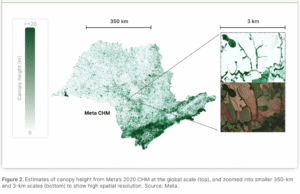
The map and the AI model are open-source and freely available, so anyone can use them to help forest projects. They enable better planning, monitoring, and verification of forest carbon projects. Reza Rastegar, Senior Manager of Research Science at Meta, stated:
“When applied thoughtfully, we believe AI research and remote-sensing tools, particularly those that are open source, have the potential to revolutionize the transparency and accessibility of the carbon market.”
Meta’s model has been validated with mean absolute errors of 2.8 meters in U.S. forests and 5.1 meters in Brazil. This reflects a promising improvement in estimating canopy height at fine scales. These advanced datasets and models are helping to track natural regeneration, selective logging, and forest degradation more accurately, which is vital for credible MMRV of carbon credits.
What’s special about this model?
- It works globally with very fine detail.
- It can help identify important areas to protect or restore.
- It can make new maps for different times if good images are available.
- It helps detect small changes in forests, like selective logging (cutting some trees but not all).
- It supports methods from carbon credit standards. This is important for those who need dynamic baselining or updating project baselines with real data from nature.
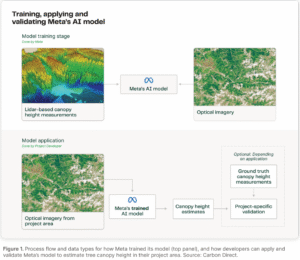
RELATED: Meta and Microsoft Secured Long-Term Carbon Credit Deals to Support Olympic Rainforest
From Pixels to Carbon Credits: Turning Data into Climate Action
Forest carbon projects use different official methods to create and verify forest carbon credits. The three main methods Meta focuses on are:
- Verra VM0045 – for improved forest management (IFM).
- Verra VM0047 – for afforestation, reforestation, and revegetation (ARR).
- American Carbon Registry (ACR) IFM – a US-based improved forest management method.
Here’s how Meta’s canopy height map and AI model fit into these methods:
- In project planning, the map helps find good parcels of forest to include, determine project boundaries, and understand forest structure.
- For dynamic baselining, especially in ARR and ACR’s IFM methods, the AI model can help update baselines based on real forest growth or loss over time.
- For reversals monitoring (tracking if carbon gains are lost, e.g., due to fire or logging), the map gives better details to detect forest disturbances.
The Fine Print: What Meta’s Model Gets Right—and Where It Struggles
Many traditional satellite products can’t reliably measure forest height or biomass in dense forests or small areas. Meta’s model, because it uses very high-resolution images, helps overcome this.
Monitoring small or fragmented forests, river corridors, or areas with selective logging is crucial. These places are difficult to track using low-resolution data.
Meta’s canopy height model is a powerful tool for estimating forest structure, but it comes with limitations. It works best with high-quality imagery at 0.5–1 meter resolution. The global canopy height map uses images from 2009 to 2020. This means it might not show current forest conditions. So, there’s a need for updated maps.
Accuracy may also drop in underrepresented forest types, so local validation with field or lidar data is advised. Using the model requires significant computing power and technical expertise, which may limit adoption.
For forest carbon projects, remote sensing offers great promise but faces barriers. There is no universal agreement among registries, buyers, and developers on acceptable methods or datasets.
In addition, technical skills, computational capacity, and access to affordable, high-quality datasets remain limited. Uncertainty around accuracy—and lack of consensus on acceptable error levels—make trust and comparability difficult.
For the identified barriers, the report authors recommend the following:
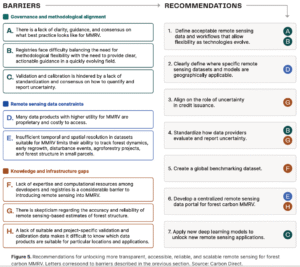
Closing the Gap Between Innovation and Impact
Experts want clearer standards for how datasets can be used. They also seek better reporting on uncertainty and clearer rules for issuing carbon credits. A global benchmarking database with verified data and a central portal for quality datasets could help boost adoption.
Moreover, easier AI tools would make this process smoother. Integrating advanced models like Meta’s into accessible platforms, alongside collaborative standard-setting, will be crucial to scaling reliable forest carbon monitoring and verification.
Examples of New and Exciting Uses of Meta’s Model
- Counting trees in agroforestry projects to monitor performance.
- Mapping old-growth forests and biodiversity hotspots.
- Detecting subtle forest degradation, like selective logging.
- Monitoring reversals (losses of carbon stored) with greater accuracy.
- Supporting more accurate estimates of above-ground biomass.
Forests are vital to fighting climate change by storing carbon, but measuring how much carbon they hold and how this changes over time is tough. New technologies like remote sensing are making this easier, faster, and cheaper.
Meta’s AI-powered canopy height map is a cutting-edge tool offering very detailed, global forest height data that can help in planning, monitoring, and verifying forest carbon projects.
The post Meta’s AI Forest Map: The Game-Changer for Carbon Tracking appeared first on Carbon Credits.
Carbon Footprint
PowerBank Embraces Bitcoin and Tokenized Energy in Bold Treasury Shift to Digital Finance
Disseminated on behalf of PowerBank Corporation.
PowerBank Corporation recently announced a new treasury strategy that includes holding Bitcoin. This move combines innovative finance with the company’s ongoing mission to develop clean energy projects. PowerBank aims to hold Bitcoin on its balance sheet. It has also teamed up with Intellistake Technologies Corp., a company focused on blockchain and digital asset custody and treasury management.
PowerBank intends to acquire Bitcoin as part of its treasury assets. This allows the company to tap into the long-term value of the cryptocurrency. Also, it remains dedicated to environmental responsibility and sustainability.
Linking Bitcoin with Clean Energy
Bitcoin mining is often criticized for high energy consumption and its impact on the environment. Some experts and companies think Bitcoin can help renewable energy grow. This is true when it is linked to clean power sources. That is the approach PowerBank follows.
PowerBank states that all Bitcoin transactions it completes will use net cash flow from verified renewable energy sources. This helps maintain its focus on sustainability.
So, Why Bitcoin?
PowerBank views Bitcoin not just as an investment but as a strategic reserve asset. Holding Bitcoin on its balance sheet can help the company hedge against inflation and economic uncertainty. This trend includes more than 40 public companies that hold Bitcoin as of 2024, says Galaxy Digital.
Bitcoin is decentralized and has a limited supply of 21 million coins. This makes it appealing for companies that want a long-term hedge against inflation. PowerBank has committed to transparency with its future Bitcoin holdings and will report them openly.
A Smart Power Duo: PowerBank x Intellistake
PowerBank has teamed up with Intellistake Technologies Corp. This partnership will help PowerBank with technical advice, custody, digital asset security, blockchain infrastructure, and treasury management. All these services support PowerBank’s Bitcoin strategy and related plans.
Through this collaboration, the company gains access to Blockchain infrastructure and digital asset custody.
Expanding Clean Energy Finance Through Digital Assets
PowerBank’s Bitcoin strategy positions it as a pioneer in linking digital assets with clean energy development. Bitcoin purchases with net cash flow generated from renewable energy can offset the electricity used in Bitcoin mining.
Research from groups like the Energy Web Foundation and the Cambridge Centre for Alternative Finance backs this idea. Using low-carbon energy for Bitcoin mining can turn it from a problem into a tool for grid management, and PowerBank is using a similar indirect approach through the use of net cash flow from renewable energy projects to acquire Bitcoin.
The announcement has attracted attention from ESG-focused investors and the broader crypto community. It shows a rising interest in how renewable energy developers can use blockchain and digital assets in their financing models.
A Bloomberg NEF survey found that approximately 60% of renewable energy developers are exploring blockchain or digital asset solutions to support project financing. If PowerBank’s approach works, it may inspire other clean energy companies to try similar strategies.
Beyond Bitcoin: Energy on the Blockchain
In addition to Bitcoin, PowerBank is advancing blockchain-based finance through its partnership with Intellistake. Intellistake specializes in blockchain, capital markets, and decentralized AI infrastructure.
Under this agreement:
- PowerBank plans to accumulate Bitcoin as a long-term reserve asset.
- Intellistake provides custody, digital security, and treasury management tools.
- Both companies will look into tokenizing real-world energy assets. This includes solar farms and battery storage systems.
Tokenization is turning physical assets into digital tokens. These tokens can be traded or sold in regulated markets. This can lead to:
- Easier access to renewable energy investments.
- Faster, transparent transfers of ownership.
- New ways to raise capital through fractional ownership.
Intellistake’s CEO, Jason Dussault, has stated that tokenization is no longer just a concept but an inevitable step for capital markets.
Analysts say tokenized real-world assets might reach a $30 trillion market by 2034, while some projected it to reach almost $19 trillion by 2033. Clean energy is a major use case because of its stable, asset-backed value.
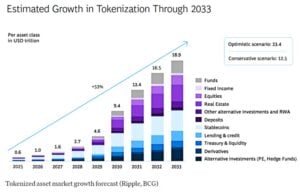
Reasons for Bitcoin as a Treasury Asset
PowerBank’s Bitcoin treasury plans reflect a broader corporate trend. Many companies view Bitcoin as:
- Scarce and resistant to inflation.
- Easily transferable with global liquidity.
- Increasingly adopted by blockchain-based financial systems.
Firms like MicroStrategy, Block, and Tesla have added Bitcoin to their balance sheets to diversify reserves beyond bonds and cash. PowerBank has not yet confirmed any Bitcoin purchases.
The company plans to make decisions based on market conditions, liquidity needs, and cash flow. PowerBank wants to keep full control of its digital assets. So, it has Intellistake providing custody infrastructure, which means no need for third parties.
A New Model for Clean Energy Finance
PowerBank generates steady revenue from its renewable energy projects. The company might use these revenues to invest in digital assets. They plan to connect clean energy with advanced financial technologies.
PowerBank has developed over 100 megawatts (MW) of renewable energy projects in the U.S. and Canada. It also has a pipeline of about 1 gigawatt (GW). This gives PowerBank a solid base to try out new financing methods.
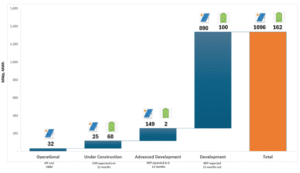
The company’s integration of Bitcoin and tokenization may change how energy developers manage their finances. The company intends to combine renewable energy projects with treasury diversification and blockchain finance. This approach opens a new frontier for decarbonization and financial technology.
As investors and utilities seek sustainable, high-yield options, PowerBank’s approach could open new value opportunities in both the energy and finance sectors.
Please refer to “Forward-Looking Statements” in the press release entitled “PowerBank and Intellistake Announce Strategic Alliance to Pioneer Digital Currencies, including Bitcoin Treasury Integration and RWA Tokenization” for additional discussion of the assumptions and risk factors associated with the statements in this report.
Intellistake and PowerBank are presently evaluating the regulatory framework for tokenization. Any tokenization will be subject to it being completed in compliance with applicable law, regulatory requirements and terms of any underlying agreements associated with PowerBank assets. The actual structure of such tokenization, the assets that would be subject to tokenization, and the associated timeline, have not yet been determined. Intellistake and PowerBank will provide further updates as material developments related to this tokenization strategy occur.
The actual timing and value of Bitcoin purchases, under the allocation strategy will be determined by management. Purchases will also depend on several factors, including, among others, general market and business conditions, the trading price of Bitcoin and the anticipated cash needs of Intellistake or PowerBank. The allocation strategy may be suspended, discontinued or modified at any time for any reason. Intellistake will support PowerBank’s establishment of custody for its digital currency purchases and PowerBank no longer intends to utilize Coinbase for this service. As of the date of this press release, no Bitcoin purchases have been made.
Disclosure: Owners, members, directors, and employees of carboncredits.com have/may have stock or option positions in any of the companies mentioned: None.
Carboncredits.com receives compensation for this publication and has a business relationship with any company whose stock(s) is/are mentioned in this article.
Additional disclosure: This communication serves the sole purpose of adding value to the research process and is for information only. Please do your own due diligence. Every investment in securities mentioned in publications of carboncredits.com involves risks that could lead to a total loss of the invested capital.
Please read our Full RISKS and DISCLOSURE here.
The post PowerBank Embraces Bitcoin and Tokenized Energy in Bold Treasury Shift to Digital Finance appeared first on Carbon Credits.
Carbon Footprint
CDR Credit Sales Hit Record High, Powering Market Growth in 2025
The voluntary carbon market is booming in 2025. Allied Offsets data showed that in the first quarter of 2025, around 780,000 CDR credits were contracted — a surge of 122% compared to the same period in 2024.
Additionally, 16 million credits were sold in the first six months of 2025 – marking it the strongest start to a year so far. The momentum is fueled by major buyers like Microsoft, aiming to be carbon negative by 2030, and by a surge in biomass-based removal methods that are reshaping corporate offset strategies.
Why Carbon Dioxide Removal Credits Are Surging
Businesses are racing to hit climate targets faster, and carbon dioxide removal (CDR) is emerging as the go-to solution. The biggest boost this year comes from biomass-based methods — like turning farming and forestry waste into tools for trapping CO₂. These projects are cheaper, easier to scale, and more accessible than high-cost tech such as direct air capture (DAC).
By early 2025, biomass CDR accounted for about 40% of credit volumes. Microsoft and other big players are securing large volumes, setting quality benchmarks, and pushing the market toward transparent, high-integrity projects.
Source: Zion Market Research
Technology Shifts in CDR
-
Biomass-based CDR — including BECCS, biochar, bio-oil, and biomass burial — made up a massive 94% of total volumes in the first half of 2025.
-
Investment focus, however, is still heavily skewed toward DAC and carbon utilization projects, despite other scalable and cost-effective CDR options.
-
More public awareness and funding diversity are needed to unlock the full potential of multiple CDR pathways.
New innovations are also redefining CDR. About 30% of new projects now use methods such as advanced soil carbon storage, bio-oil injection, and marine carbon removal, which can store CO₂ for hundreds or even thousands of years.
Digital MRV platforms are also transforming the space, offering real-time tracking to boost transparency, prevent fraud, and speed up purchase decisions. Meanwhile, integrated projects like agroforestry, regenerative agriculture, and biodiversity restoration are gaining traction for their multi-benefit environmental impact.
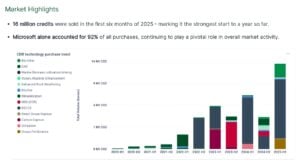
Environmental Benefits of Biomass CDR
Biomass approaches like biochar and BECCS offer cost-effective solutions, often ranging from $80–$200 per ton.
These methods work within a circular economy model — repurposing agricultural and forestry waste into long-term carbon storage. BECCS delivers a dual benefit by producing renewable energy while storing CO₂ underground.
However, without strict MRV protocols, poorly managed biomass projects risk deforestation or biodiversity loss. Global removal capacity is still only 41 million tons CO₂/year, yet it needs to grow 25–100x by 2030 to meet climate goals.
Market Segmentation
By technology: DAC, afforestation & reforestation, soil carbon sequestration, BECCS, ocean-based CDR, and enhanced weathering.
-
DAC, holding 67% of global revenue in 2023, is set for the fastest growth thanks to flexible deployment and industrial CO₂ utilization.
By application: Consumer products, energy, transport, and industrial sectors.
-
The industrial sector leads due to rising emissions from cement, steel, and chemicals.
CDR Buyer Trends in 2025
-
Financial services firms led in the number of unique buyers, while technology companies dominated purchase volumes with over 50 million credits bought so far.
-
Half of all buyers in early 2025 were first-time participants, collectively purchasing around 6 million credits which is a promising sign of market expansion.
Market Momentum and Future Projections
The CDR market hit $3.9 billion in Q2 2025, with biomass projects making up 99% of transactions. Microsoft continues to drive momentum by locking in long-term purchase agreements that help projects scale.
Market forecasts suggest CDR’s value will grow from $842 million in 2025 to $2.85 billion by 2034, while durable carbon credits could soar to $14 billion by 2035, growing 38% annually.
Rising buyer expectations — around permanence, transparency, and quality — are further reinforced by new regulations, particularly in Europe, pushing out low-integrity credits.
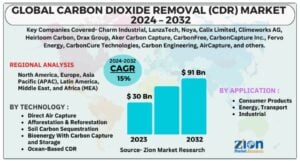
Opportunities and Challenges Ahead
The CDR market stands to benefit from government-backed carbon incentives, increasing demand for carbon credits, and the potential to create new jobs in sectors such as farming, engineering, and construction. However, its growth faces hurdles, including limited public awareness of CDR’s advantages and the risk of political instability slowing adoption.
What’s Next for Carbon Dioxide Removal?
The market is at a turning point. Experts predict a blend of nature-based and durable removals, with the latter gaining ground toward 2050 as quality demands rise. The future will rely on smarter investments, high-fidelity data tracking, and clear global standards.
Corporate leaders like Microsoft are already showing the way — proving that transparency, permanence, and innovation will define the next era of climate action.
- READ MORE: MOL Becomes the First Japanese Shipping Firm to Retire Tech-Based CDR Credits Through NextGen
The post CDR Credit Sales Hit Record High, Powering Market Growth in 2025 appeared first on Carbon Credits.
-
Climate Change2 years ago
Spanish-language misinformation on renewable energy spreads online, report shows
-
Climate Change Videos2 years ago
The toxic gas flares fuelling Nigeria’s climate change – BBC News
-

 Greenhouse Gases1 year ago
Greenhouse Gases1 year ago嘉宾来稿:满足中国增长的用电需求 光伏加储能“比新建煤电更实惠”
-

 Climate Change1 year ago
Climate Change1 year ago嘉宾来稿:满足中国增长的用电需求 光伏加储能“比新建煤电更实惠”
-

 Carbon Footprint1 year ago
Carbon Footprint1 year agoUS SEC’s Climate Disclosure Rules Spur Renewed Interest in Carbon Credits
-
Climate Change2 years ago
Why airlines are perfect targets for anti-greenwashing legal action
-
Climate Change Videos2 years ago
The toxic gas flares fuelling Nigeria’s climate change – BBC News
-
Climate Change2 years ago
Some firms unaware of England’s new single-use plastic ban










